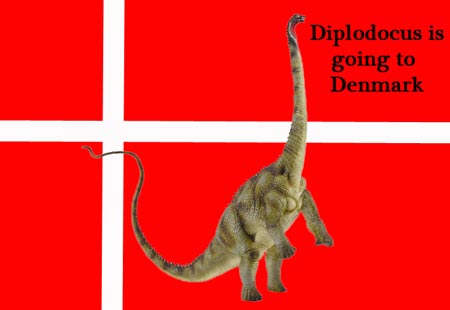Rare Diplodocus Fossil Goes to Denmark
“Misty” The Diplodocus Skeleton Purchased by the Natural History Museum of Denmark
The mounted, fossilised remains of a seventeen-metre-long Diplodocus sold at auction last month has been purchased by the Natural History Museum of Denmark. The museum, which has links to the University of Copenhagen celebrates it’s tenth anniversary on New Years Day and the purchase of this Jurassic sauropod skeleton makes a nice Christmas/Tenth anniversary present for the institution.
Diplodocus Skeleton
The Museum came into being on the 1st January 2004 with the amalgamation of a number of museums (including the geological and zoological museums) and other organisations into one body. Everything Dinosaur reported on the auction of “Misty” – as this was the nickname of the mounted specimen, earlier in the year. When the auction took place, the Diplodocus sold for £400,000 GBP (approximately 472,000 euros) but at the time the name of the purchaser was not revealed.
To read more about the sale of “Misty” the Diplodocus: Diplodocus Goes Under the Hammer.
Rare Specimen
Believed to one of just a handful of near complete specimens in the world that represent the Diplodocus genus, the fossil material was originally excavated in Wyoming and from there it went to Holland for further preparation work, cleaning and mounting. In an announcement to the press, the Copenhagen based museum confirmed that it had bought this auction lot. The dinosaur, thought to be a female, was purchased following a donation from the Obel Family Foundation.
Diplodocus on its Way to Denmark
Picture credit: Everything Dinosaur
The model depicted on the flag of Denmark is one from the CollectA Prehistoric Life model collection, to view this extensive range: CollectA Prehistoric Life/Prehistoric World Models.
Museum Director Morten Meldgaard commented:
“To own a giant dinosaur is, of course, the dream of any natural history museum. In order to understand the nature and the world we live in, we have to understand the past, and more than anything else, a dinosaur is an object that connects us with the distant past.”
The Evolution of Life Gallery
The Diplodocus will very probably go on exhibit within a gallery dedicated to the evolution of life on Earth, amongst the Museum’s existing, extensive fossil collection. With the amalgamation of the various museums and other institutions into a single attraction visitors can marvel at the fossils, hundreds of minerals and examine the huge zoological collection as well as enjoy the famed Botanical gardens.
Christen Obel, the Chairman of the Obel Family Foundation stated:
“I think it’s quite obvious and right that the Natural History Museum of Denmark should own a dinosaur. So when we suddenly had the opportunity to give the museum this early Christmas present, we jumped at the chance.”
Despite being a small country, the geology of Denmark is extremely varied and many different types of fossil bearing sedimentary deposits are exposed and can be explored. A number of quarries grant permission to parties of fossil hunters and there are a number of sites along Denmark’s coast where different types of fossil can be found, including many vertebrates (fish). Intriguingly, Denmark is one of the few countries in Europe where the K-T boundary, that thin iridium layer that separates the Mesozoic from the Cenozoic can be accessed.
It looks like the Diplodocus specimen has found a good home and it is pleasing to hear that this specimen will still be able to be viewed by the public and utilised by palaeontologists carrying out research.


